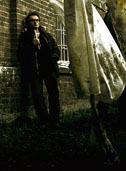
Movie Guru Rating:

Comment
on this review
| |

28 Days Later plays on our worst nightmares
by Lee Gardner
Early on in 28 Days Later, the camera slowly pulls back from a wall in a church, revealing row after row of mammoth letters scrawled all the way up a tall stairwell. Fully unveiled, the message reads repent, the end is extremely fucking nigh.
In an age of bioterrorism fears, not to mention SARS, monkeypox, and mad-cow disease (which was most threatening in the United Kingdom, from whence 28 Days Later hails), the time is ripe for a cautionary tale a la The Day the Earth Stood Still, a cinematic lecture on how we must cease our self-destructive madness and face the worst-case scenarios or reap the results of our thoughtless progress. And British director Danny Boyle (Shallow Grave, Trainspotting, The Beach) serves up just such a warning in the form of a grim and gritty digital-video zombie movie. That's right, a zombie movie. The surprising result is a ready-made white-knuckle horror classic, and the most mournfully thought-provoking film to hit big screens this year.
After an opening it would be a shame to spoil, average bloke/blow-to-the-head sufferer Jim (Cillian Murphy) comes to in a deserted hospital after a prolonged unconsciousness. At first, he is disturbed to find he has once-bustling London seemingly all to himself. He is even more disturbed to discover that he is not alone: All but a handful of Londoners have been infected by a wildly contagious and fast-acting virus, a gruesome mix of rabies and hemorrhagic fever. Society has completely collapsed—as far as anyone can tell, worldwide—and for the uninfected every minute is a tense struggle to remain alive and disease-free. Jim stumbles across tough chick Selena (Naomie Harris), who saves his life in spite of her rigorous self-preservation ethic. Along with father-and-daughter team Frank and Hannah (the great Brendan Gleeson and Megan Burns, respectively), they head out of the city following a faint radio signal, although salvation turns out to be not quite what they expected.
In many ways, 28 Days Later is George A. Romero's Dead trilogy (Night of the Living Dead, Dawn of the Dead, and Day of the Dead) shamelessly appropriated and compressed into one film, complete with salt-and-pepper protagonists (Murphy and Harris), a gleeful post-apocalyptic shopping spree, and a band of twitchy soldiers (commanded by Shallow Grave's Christopher Eccleston). But Boyle's infected are a different breed from Romero's stumbling cadavers. Fully bent on mayhem, they're as fast and determined as you are at your most adrenalized. After a couple of reels, every quiet moment is suffused with dread that another one of those things is going to smash through a window or a door, gnashing and clawing and spraying blood. And when blood-to-blood contact is made, the virus takes less than half a minute to turn your best friend or last surviving relative into your worst nightmare if you don't kill them immediately. It makes for an unnerving multiplex outing to say the least.
Like its antecedents, 28 Days Later was done on the relative cheap and quick, and it features logic lapses and story holes bound to obsess nitpickers. And like Romero's trilogy, the third act is the weakest. But Boyle, working from a script by The Beach author Alex Garland, does a brilliant job of making this outlandish possible future resonate in the here and now. Shooting on digital video not only saved money, it paradoxically makes everything that happens seem more real. Instead of watching events unfold in the distancing perfection of 35mm, the grain and jiggle of DV brings events more into the commonplace realm of home movies or surveillance footage, and the Dogme-proven intimacy of DV helps out a largely unknown cast who don't have much time to make their presence felt. Meanwhile, Garland and Boyle's vision of the end of the world is both grim and affecting, as small touches here and there—from a Sept. 11-esque have-you-seen? bulletin board to the survivors' forced subsistence diet of vending-machine snacks to the heartbreaking last line of a suicide note—drive home how much we all have to lose.
While artful, 28 Days Later is most definitely entertainment, complete with (welcome) moments of comic relief and a fairly traditional resolution. But Boyle makes it abundantly clear that no one should leave the theater feeling self-congratulatory. The film opens with gruesome news footage of mob violence, the grim joke being that this is our world before infection. The outbreak itself begins when our best human intentions blindly meet up with some of our very worst. By the time the film ends and the notion has been underlined that we must Only Connect, even when up to our asses in zombies, the "heroes" have been responsible for as much on-screen savagery as the infected, and not just against the infected. The human race may survive in spite of itself, Boyle seems to say in summation, but not necessarily because it deserves to.

June 26, 2003 * Vol. 13, No. 26
© 2000 Metro Pulse
|